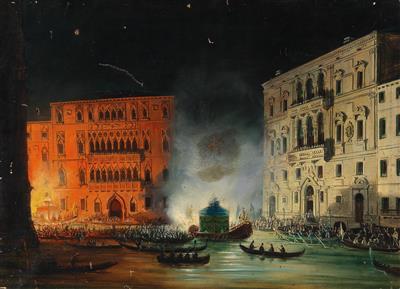Giovanni Grubas

(Venice 1830–1919 Pula)
Venice – Festivities on the Grand Canal in 1838 in honour of Emperor Ferdinand (1793–1875) in front of Palazzo Foscari and Palazzo Balbi, lower right the signature remains G. Grubas are visible, on the reverse old handwritten confirmation, oil on canvas, 56 x 76.5 cm, unframed, damaged, perforations, restored, (Rei)
Provenance:
Private Collection Romania.
The celebrations in honour of Emperor Ferdinand I of Austria at the Canal Grande took place in 1838 following his coronation as King of Lombardy and Venice. The canal is bordered by two significant Palazzi, the Palazzo Foscari and the Palazzo Balbi. The late Gothic Palazzo Foscari, also named Ca’ Foscari, today houses the University of Venice. This was founded in 1868 first as a trade school, after which it served as a hospital and later as a barracks under Austrian occupation, amongst other things. It was commissioned by the Doge Francesco Foscari in 1453. The building that previously stood on the site, which Foscari had acquired at auction, was demolished to give way to the new palace. The bottom floors of the palace served originally as storage rooms. On the two upper floors was the piano nobile. Opposite the Palazzo Foscari is the Palazzo Balbi: a building originating from the second half of the 16th century, which is now the seat of the municipal council of Venice. In 1807, the palace accommodated Napoleon Bonaparte. This great military commander, too, is said to have looked out from the balcony across the famous regattas on the Canal Grande, of which the palace constitutes the finish line.
Giovanni Grubas (also sometimes found written as “Grubacs”) was, like his father Carlo Grubas, a veduta painter. Giovanni studied at the Academy in Venice. In his early work, he orientated himself on 18th-century cityscapes; subsequently, works of the nineteenth century became his model. Ippolito Caffi, in particular, influenced the painter considerably. The shimmering light so typical of Venice is reflected in the views of both painters. The broad colour spectrum and the busy hustle of his Venice pictures lend them a liveliness which captures Venetian daily life. Like Caffi, Grubas is able to enliven the atmosphere in his depiction of nocturnal scenes of celebration with an accentuated colour scheme. In the present painting, Grubas captures the atmosphere through the partial illumination of certain areas, through which he emphasises the celebratory event of the scene. The decorated gondolas of the parade roll by before the Palazzo Foscari, which is suffused with reddish orange hues. In the centre, behind which the Rio di Ca’ Foscari is situated, wafts of mist rise upwards, lending a dramatic effect to the nocturnal activity. Once more, we can recognise Grubas’ talent for cultivating a particular mood in his paintings and imparting it to the viewer.
Specialist: Mag. Dimitra Reimüller
 Mag. Dimitra Reimüller
Mag. Dimitra Reimüller
+43-1-515 60-355
19c.paintings@dorotheum.at
27.04.2017 - 18:00
- Realized price: **
-
EUR 40,000.-
- Estimate:
-
EUR 10,000.- to EUR 15,000.-
Giovanni Grubas
(Venice 1830–1919 Pula)
Venice – Festivities on the Grand Canal in 1838 in honour of Emperor Ferdinand (1793–1875) in front of Palazzo Foscari and Palazzo Balbi, lower right the signature remains G. Grubas are visible, on the reverse old handwritten confirmation, oil on canvas, 56 x 76.5 cm, unframed, damaged, perforations, restored, (Rei)
Provenance:
Private Collection Romania.
The celebrations in honour of Emperor Ferdinand I of Austria at the Canal Grande took place in 1838 following his coronation as King of Lombardy and Venice. The canal is bordered by two significant Palazzi, the Palazzo Foscari and the Palazzo Balbi. The late Gothic Palazzo Foscari, also named Ca’ Foscari, today houses the University of Venice. This was founded in 1868 first as a trade school, after which it served as a hospital and later as a barracks under Austrian occupation, amongst other things. It was commissioned by the Doge Francesco Foscari in 1453. The building that previously stood on the site, which Foscari had acquired at auction, was demolished to give way to the new palace. The bottom floors of the palace served originally as storage rooms. On the two upper floors was the piano nobile. Opposite the Palazzo Foscari is the Palazzo Balbi: a building originating from the second half of the 16th century, which is now the seat of the municipal council of Venice. In 1807, the palace accommodated Napoleon Bonaparte. This great military commander, too, is said to have looked out from the balcony across the famous regattas on the Canal Grande, of which the palace constitutes the finish line.
Giovanni Grubas (also sometimes found written as “Grubacs”) was, like his father Carlo Grubas, a veduta painter. Giovanni studied at the Academy in Venice. In his early work, he orientated himself on 18th-century cityscapes; subsequently, works of the nineteenth century became his model. Ippolito Caffi, in particular, influenced the painter considerably. The shimmering light so typical of Venice is reflected in the views of both painters. The broad colour spectrum and the busy hustle of his Venice pictures lend them a liveliness which captures Venetian daily life. Like Caffi, Grubas is able to enliven the atmosphere in his depiction of nocturnal scenes of celebration with an accentuated colour scheme. In the present painting, Grubas captures the atmosphere through the partial illumination of certain areas, through which he emphasises the celebratory event of the scene. The decorated gondolas of the parade roll by before the Palazzo Foscari, which is suffused with reddish orange hues. In the centre, behind which the Rio di Ca’ Foscari is situated, wafts of mist rise upwards, lending a dramatic effect to the nocturnal activity. Once more, we can recognise Grubas’ talent for cultivating a particular mood in his paintings and imparting it to the viewer.
Specialist: Mag. Dimitra Reimüller
 Mag. Dimitra Reimüller
Mag. Dimitra Reimüller
+43-1-515 60-355
19c.paintings@dorotheum.at
|
Buyers hotline
Mon.-Fri.: 10.00am - 5.00pm
kundendienst@dorotheum.at +43 1 515 60 200 |
| Auction: | 19th Century Paintings |
| Auction type: | Saleroom auction |
| Date: | 27.04.2017 - 18:00 |
| Location: | Vienna | Palais Dorotheum |
| Exhibition: | 15.04. - 27.04.2017 |
** Purchase price incl. charges and taxes
It is not possible to turn in online buying orders anymore. The auction is in preparation or has been executed already.
More objects by this artist
-

Estimate:
EUR 10,000.- to EUR 14,000.-
